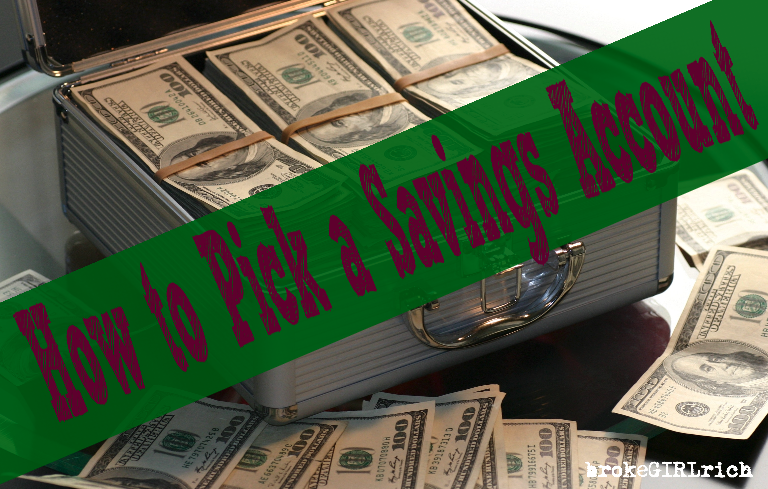
How to Pick a Savings Account | brokeGIRLrich
A few weeks ago, we talked about how to pick a checking account.
Today, let’s look into how to pick a savings account.
First of all, why would you want a savings account if you already have a perfectly good checking account?
I think there are two main benefits to having a savings account. The first is that they do usually earn more interest than a checking account. The second is that the out-of-sight-out-of-mind trick is a good one. If you have a lot of money just sitting in your checking account, you may tell yourself it’s not there to be spent, but a lot of times, it’s easier to just move it out of your checking account to keep from accidentally overspending.
A bonus reason is that many banks let you open multiple savings accounts, which can be really useful to help you track any goals you’re saving for. Personally, I have a savings account for:
- my emergency fund
- house down payment
- new car
- contacts
- car insurance
- travel
- taxes
Essentially all my medium and short term goals.
This makes it really easy to see how I’m doing with each of those goals.
When picking a savings account, you look for a lot of the same things you’d look for when picking a checking account.
The key things to look for are:
- Interest Rates
- Minimum Balances
- Monthly Fees
- Number of Required Transactions
- Overdraft Help
- Ease of Transferring Money
Interest Rates
This is really a key thing to look for in your savings account. Interest rates allow you to earn a little money while your savings sit in the bank.
I’m not gonna lie, it’s not a lot. Savings account interest rates are low and have even plummeted lower than usual lately. When I was opening accounts a few years ago, around 1% was phenomenal. My accounts are now at less than half that.
Banks also sometimes change their interest rates over time, so if you already have a savings account, it’s worth double checking that the interest rate is still the same and if not, consider moving your savings.
I know CapitalOne recently lowered theirs. For a long time they had one of the highest interest rates, which is why I keep my emergency savings there. After the last interest reduction, I realized that I should probably shop around and consider moving.
Minimum Balance
Some banks require you to keep a minimum balance in your savings account. There are many banks that don’t require this, so if yours does, you can find one that doesn’t.
That being said, a lot of banks with better interest rates do have requirements like keeping a minimum amount in the savings account or they offer a higher interest rate for keeping a certain amount of in the account.
Monthly Fees
Some banks can have a $5 or $10 a month maintenance fee, which is most likely not worth paying.
Make sure you can confirm there are no monthly or maintenance fees on the savings account you open.
Number of Required Transactions
Another way some banks waive maintenance fees is by requiring a certain number of transactions a month. Some banks also waive minimum balance requirements if you meet a certain number of transactions a month.
I think it’s best to skip banks that require this in a savings account. The main hope for a savings account is that you don’t access it all that often.
Overdraft Help
A cool feature that many banks promote is that if your checking and savings account are at the same bank, you can link them so that if you ever do overdraft, the bank will just use the money in your savings account.
Of course, we always want to avoid overdrafting, but if it happens once in a while to you, this can save you some money on overdraft fees in the long run. If you know you’re likely to abuse it though, it might be best to open your savings account at another institution.
Ease of Transferring Money
You want to make sure that you don’t get charged for transfers. That’s rare, but many banks will charge you a fee for expedited transfers. Make sure you understand that transfer interface on the website so you don’t get hit with those charges.
It’s also helpful to know how many days it will take to transfer the money. If you’re a credit card user, you have some more flexibility here because you just need the money transferred in time to pay your bill, but those who rely more on cash probably want to keep in mind that there is usually a 2-3 day window between transfers before the money clears into your checking account.
I’m personally an advocate for keeping your savings at a different bank than your checking account. I like to make it harder to touch the money. Now, to be fair, it takes all of navigating to another website and a few clicks to make transfers when I have to, but I prefer that to having my checking and savings pop up on the same screen.
Over time, this has really helped me get in the mindset that what’s in my checking account is what I have to spend.
Currently, my savings accounts are at:
And as of writing this in February 2021, the highest interest rates with small or minimal required deposits can be found at (though I’ve not used all these banks):
- Synchrony Bank (.6%)
- Comenity Bank (.6%)
- Vio Bank (.57% – $100 min. to open)
- Ally (.5%)
- American Express Bank (.5%)




Pingback: Where Is The Most Secure Place To Invest My Money Right Now? - brokeGIRLrich
Pingback: Where Is The Most Secure Place To Invest My Money Right Now? – brokeGIRLrich – Economics Stocks